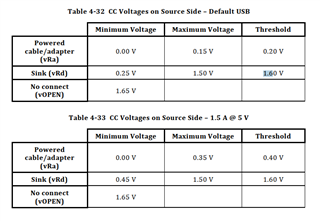Other Parts Discussed in Thread: TPS65987, TPS65987D
We have a battery-powered board that has a USB-C connection to a tablet that is managed by the TPS65987DDH. We are able to charge the tablet and the tablet is able to provide power to VBUS when the battery is disconnected, so the power aspect of the USB PD chip is working. However, we are unable to see data on any connected device (tried both a tablet and a laptop).
When we took the D+ and D- data lines directly off the board (soldered wire-to-board) and into a connector (so no CC connections, just GND and data lines to the laptop), the laptop was able to communicate with the board, demonstrating that the data lines are working properly. The problem is only when using a normal USB-C to USB-C connection between the tablet or laptop and the board. We assume this is an issue with the firmware configuration. Our configuration project is attached here. Cayetano_TPS65987_Firmware_DataComm.pjt
We have tried other configurations and advanced settings to no avail.
Thanks for any help you can give.



